It's all about the classical music composers and their works from the last 400 years and much more about music. Hier erfahren Sie alles über die klassischen Komponisten und ihre Meisterwerke der letzten vierhundert Jahre und vieles mehr über Klassische Musik.
Total Pageviews
Saturday, September 21, 2024
While My Guitar Gently Weeps (Taken from Concert For George)
The Hero in Women’s Clothes: Saint Saëns’ Le Rouet d’Omphale
by Maureen Buja, Interlude
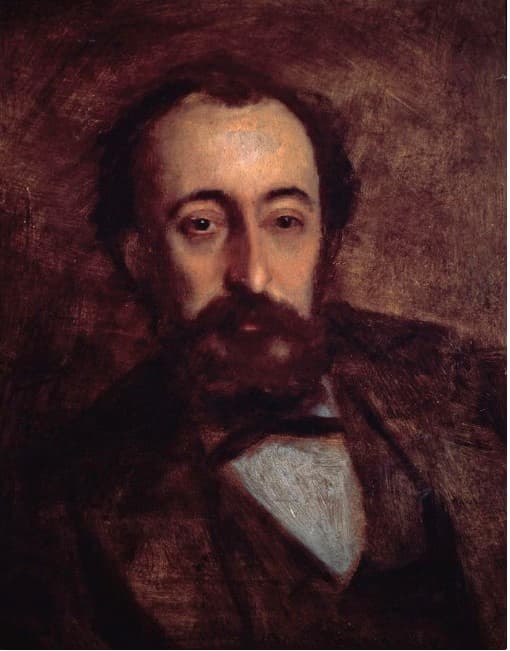
Gustave Jacquet: Portrait of Camille Saint-Saëns, 1870
Omphale was the queen of Lydia, in the cross-Bosporus region of modern-day Turkey. After her husband’s death, she reigned as queen. She comes into our knowledge as the keeper of Hercules after his murder of Iphitos, a prince and one of Jason’s Argonauts.
After Hercules had completed his Twelve Labours, he came to Ochelaia to compete in an archery competition. The prize was King Eurytus’ daughter Iole’s hand in marriage. Despite winning the competition, Eurytus and his sons (except for Iphitos) refused to give Hercules the prize because he had killed his children by his earlier wife Megara. Megara had been given to Hercules by her father, the King of Thebes, and they had several sons together. Unfortunately, Megara hated her husband and so, in a fit of temporary madness, Hercules killed all their children and then his wife.
Iphitos, the sole supporter of Hercules, went to see Hercules after he was blamed for the loss of cattle stolen by Autolycus, a notorious thief. Iphitos told Hercules he would help him look for the stolen cattle but Hercules went mad again and threw Iphitos from walls of the city of Tiryns. Apollo then sentenced Hercules to serve Omphale for one year… dressed as a woman and doing women’s work.
Because of the story’s gender implications, it was a favourite of artists. Generally, the illustrations show Hercules using a distaff to spin wool.
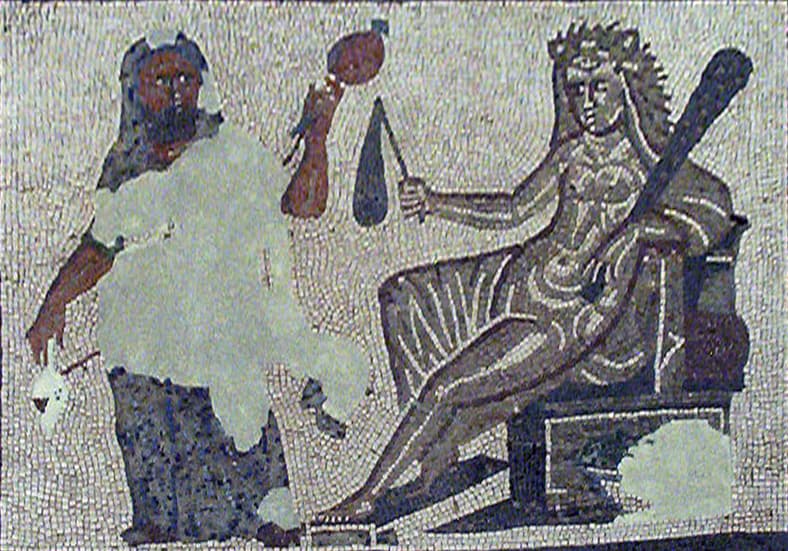
Roman Mosaic from Spain: Hercules and Omphale, 3rd century
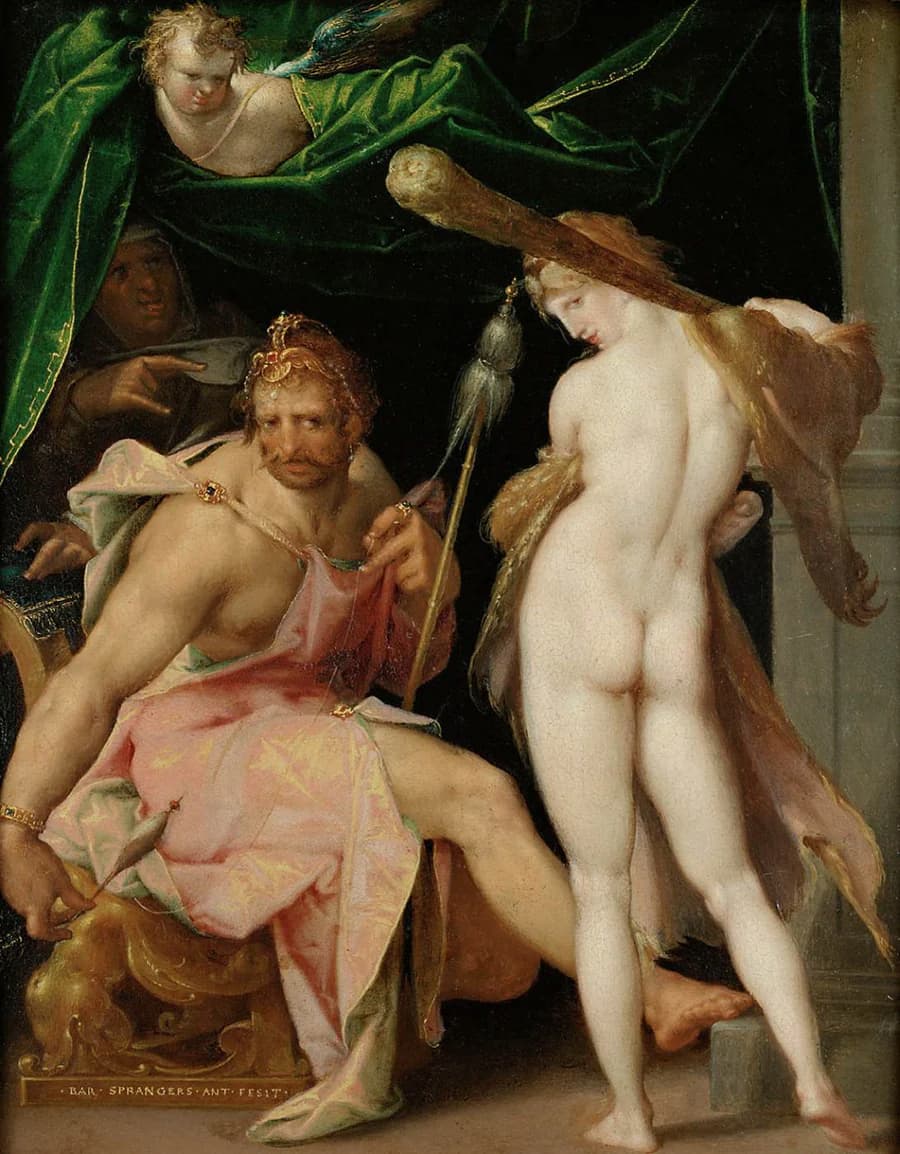
Bartholomaeus Spranger: Hercules and Omphale, ca. 1600 (Vienna: Kunsthistorisches Museum)
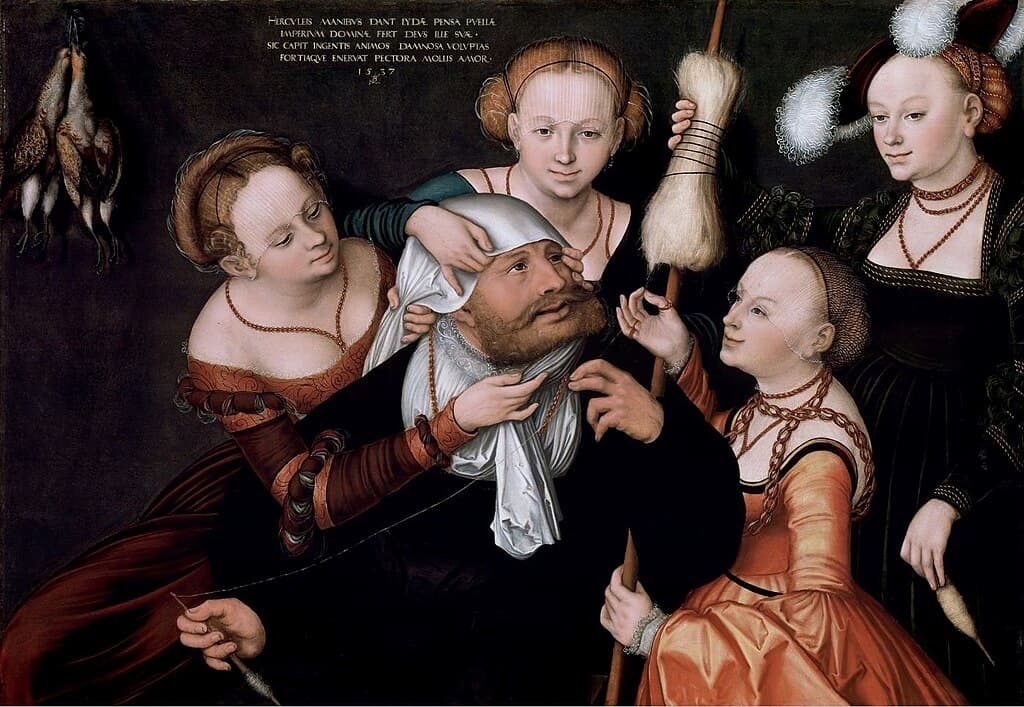
Luca Cranach the Elder: Hercules and Omphale’s maids, 1537 (Braunschweig: Herzog Anton Ulrich-Museum)
The music takes up the idea of spinning in its opening, but underneath are the groans of Hercules. The violins and woods take up the idea of Omphale mocking the fallen hero. Saint-Saëns said that he knew very well that there were no spinning wheels before the Middle Ages and explained at the beginning of the score that the wheel was ‘merely a pretext, chosen simply from the point of view of rhythm and general atmosphere of the piece’. His real subject was that of ‘feminine seduction, the triumphant struggle of weakness against strength’.
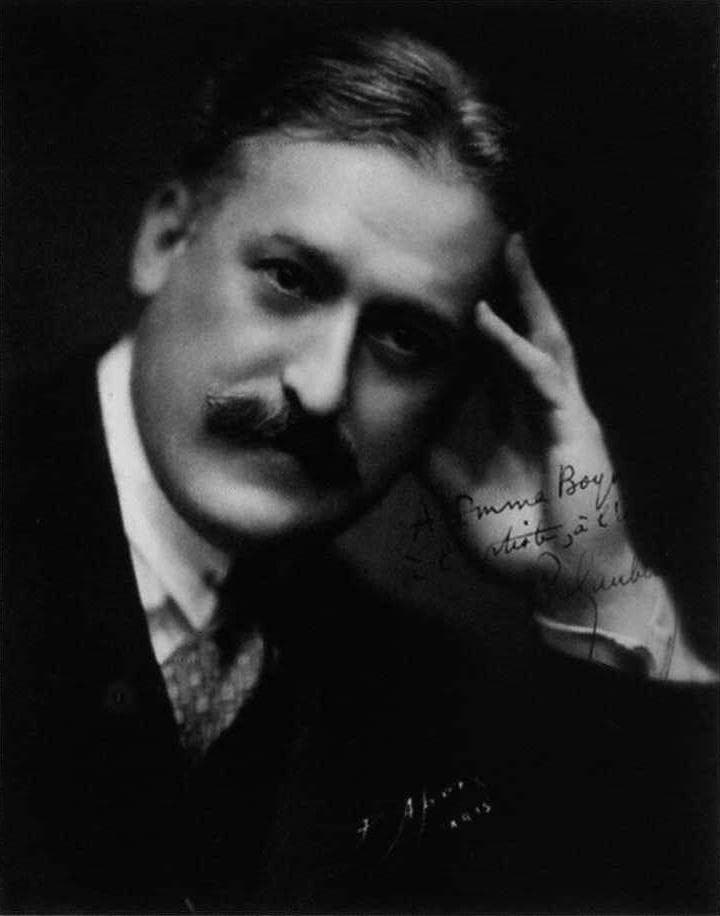
Philippe Gaubert, ca 1920
This recording was made in 1927 in Paris with Philippe Gaubert leading the Orchestre de la Société des Concerts du Conservatoire. Philippe Gaubert (1879—1941) began studying flute at the Paris Conservatoire at age 13 and rose to be one of the most important French musicians in the inter-war years. He was not only professor of flute at the Conservatoire (Marcel Moyse was one of his students), but principal conductor of both the Paris Opera and the orchestra on this recording.
The Orchestre de la Société des Concerts du Conservatoire was founded in 1828 and was made up of the Conservatoire faculty and students. Gaubert was their chief conductor from 1919–1938, succeeded by Charles Munch. The orchestra folded in 1967, and a new orchestra, the Orchestre de Paris, was formed, with Charles Munch returning as their music director for their first two years (1967–1968).
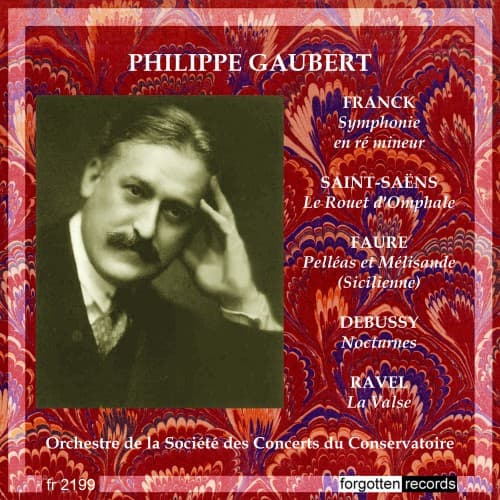
Performed by
Philippe Gaubert
Orchestre de la Société des Concerts du Conservatoire
Recorded in 1927
Violence Against Men: The Age of the Castrato
Fairy tales normally start with “Once upon a Time,” and generally end with “and they lived happily ever after.” But some of the supposed musical fairy tales I’ve been reading about are not nice stories at all. I am talking about countless young boys who underwent castration for musical purposes. What a ghastly convention practiced almost exclusively in Italy throughout the 17th and 18th centuries. Historians tell us, “the taste for castrato voices arose mainly because in large parts of Italy, including the Vatican, women’s voices were not allowed in church.” Since puberty turned choirboys into males and falsettists were considered unsatisfying, the horrid practice began. In a disgusting game of twisting your arm, princely states, leading churches or singing companies approached the parents of a boy who was considered the most talented singer in his church choir. Boys were generally recruited before the age of twelve and from the poorest areas and the poorest families. Since the leading castratos were among the most famous and most highly paid musicians in Europe, it supposedly offered great financial security for many families facing starvation.
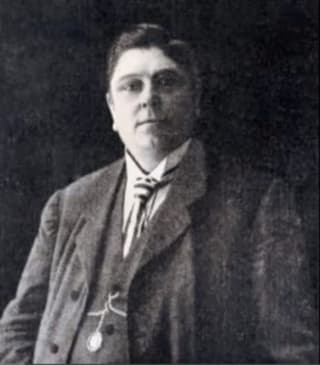
Alessandro Moreschi, 1900
Surgeons used minimal anaesthesia while performing the “operation.” On occasion, “a certain quantity of opium was given to persons designed for castration, whom they cut while there were in their dead sleep…but it was observed that most of those who had been cut after this manner died.” If the boy happened to survive the operation, the lack of testosterone made his thoracic cavity developed greatly, “while the larynx and the vocal cords developed much more slowly.” Combined with intensive training, castrati often had unrivalled lungpower and breath capacity. Singing through small and child-sized vocal chords, their voices were extraordinarily flexible and quite different from the equivalent adult female voice. We only have a single sound document to give us a taste of what a castrato voice actually sounded like. Alessandro Moreschi (1858-1922), the last Sistine castrato, was known as “The Angel of Rome” at the beginning of his career. When he made his recordings in 1902 and 1904, he was clearly past his prime, but we still get a fascinating glimpse into the sound world of the castrato.
Subjecting boys to the “operation” produced a host of different outcomes. A leading scholar writes, “There were high-sopranos, mezzos, and altos, strident voices and sweet ones, loud and mellow voices, more and less flexible throats, very tall men and very short, well and ill-proportioned castrati.” The vast majority of castrati were mediocre or bad singers and became low-level performers traveling between small towns. A very small number, however, reached unprecedented fame, and their abilities had great influence on the development of both oratorio and opera. Let’s go ahead and meet some of the most famous castrati and the repertory they inspired, starting with Giovanni Grossi, nicknamed “Siface” (1653–1697). That particular nickname originated from his stellar performance of “Syphax” in Cavalli’s Scipione affricano in Rome in 1671. He was in the service of the Duke of Modena, and he sang at the opening of the “Teatro Grimani” in Venice. It is said, that his fame even attracted the attention of Queen Christina of Sweden in Rome.
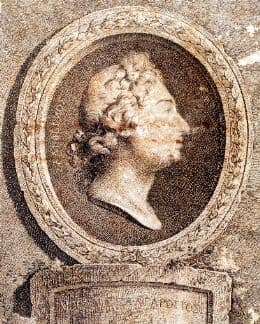
Giovanni Grossi, nicknamed “Siface”
Siface traveled to Paris and London, and a contemporary witness reports. “I heard the famous singer, the Eunuch Cifacca, esteemed the best in Europe and indeed his holding out and delicateness in extending and loosing a note with that incomparable softness, and sweetness was admirable: For the rest, I found him a mere wanton, an effeminate child; very coy and proudly conceited.” His beautiful voice was sadly contrasted by his bad temper, arrogant behaviour, and volatile temperament. Like Alessandro Stradella, “Siface” was murdered for an indiscreet affair, about which he foolishly boasted. When Siface traveled between Ferrara and Bologna, where he was engaged to sing, he was killed by musket fire at the hands of assassins hired by the woman’s family. The murder created a great scandal, and the Duke of Modena made sure the guilty party was held accountable. Siface’s voice was long remembered; in 1741, he was still “famous beyond any, for the most singular beauty of his voice.”
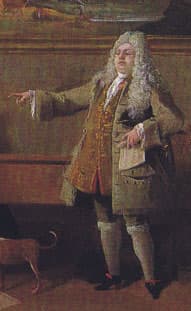
Nicolo Grimaldi, nicknamed “Nicolini”
The famed alto castrato Nicolo Grimaldi, nicknamed “Nicolini” (1673–1732) was considered the leading male singer of his age. The critic and musicologist Charles Burney described him as “a great singer and still greater actor.” Joseph Addison called him “the greatest performer in dramatic music that is now living or that perhaps ever appeared on a stage.” Born in Naples, Nicolini sang in Naples Cathedral and the royal chapel from 1690. He frequently appeared in opera and, during his early career, was primarily associated with Alessandro Scarlatti. In fact, he sang in the premières of Scarlatti’s La caduta de’ Decemviri (1697), Il prigioniero fortunato (1698), Arminio, L’amor generoso and Scipione nelle Spagne (1714), Tigrane (1715) and Cambise (1719). He took part in thirty-six productions in Naples and thirty-four in Venice, and countless composers created roles for him.
When Nicolini went to London in 1708, he became partly responsible for the increasing popularity of Italian opera in London. He made his England début at the Queen’s Theatre in Haym’s arrangement of Scarlatti’s Pirro e Demetrio. That performance was a huge success, and he signed a three-year contract with Owen Swiney. He sang in all the operas during that period and also sang the title role in the first performance of Handel’s Rinaldo. Until the age of 50, Nicolini “followed the pattern typical for star castrati.” Instead of retiring, however, Nicolini began to take on characters whose age approximated his own. Between 1727 and 1731, all new roles specifically written for him were typical tenor roles. These roles helped Nicolini “to conceal his vocal liabilities—shortness of breath, diminished range and sound quality—as they lent themselves to situations in which characters express passions such as vengefulness, disdain, imperiousness, reproachfulness or remorse.” In 1731, Nicolini was engaged to sing in Pergolesi’s first opera Salustia, but he died during rehearsals.
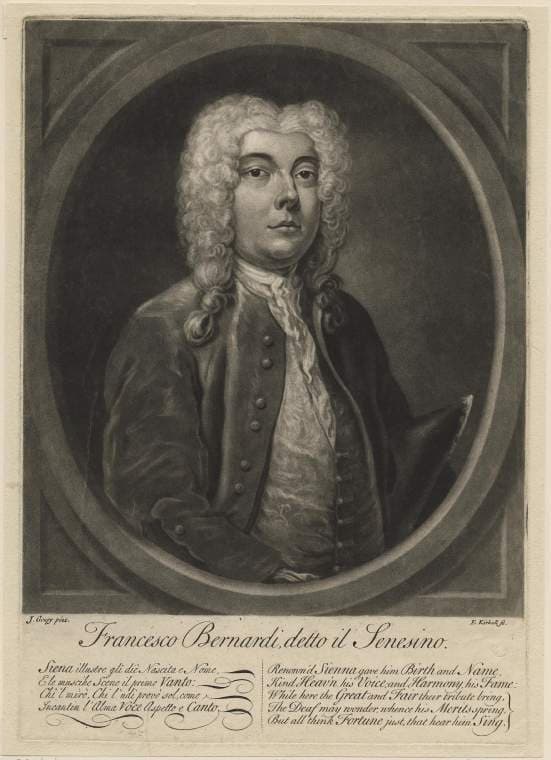
Francesco Bernardi, nicknamed “Senesino”
Francesco Bernardi (1686–1758) was born in Siena, and his nickname “Senesino” was derived from his birthplace. He became one of the most acclaimed castrato singers of his day, and his vocal ability was described in some detail. “He had a powerful, clear, equal and sweet contralto voice, with a perfect intonation and an excellent shake. His manner of singing was masterly, and his elocution unrivalled. Though he never loaded Adagios with too many ornaments, yet he delivered the original and essential notes with the utmost refinement. He sang Allegros with great fire and marked rapid divisions from the chest in an articulate and pleasing manner. His countenance was well adapted to the stage, and his action was natural and noble. To these qualities, he joined a majestic figure.” Senesino initially toured a huge number of Italian theatres and was engaged for Dresden in 1717. He commanded a huge salary but was fired for insubordination in 1720. Apparently, he refused to sing one of the arias from Heinichen’s Flavio Crispo, and tore up the part.
George Frideric Handel, who had been scouting Senesino, brought him to London and engaged him for his company. Senesino joined the Royal Academy of Music for its second season in September 1720. He made his début at the King’s Theatre on 19 November in Giovanni Bononcini’s Astarto and remained a member of the company until June 1728. Senesino sang in all 32 operas produced during this period, and that included seventeen leading roles composed by Handel. Senesino was a superstar, and described as “beyond Nicolini both in person and voice… and beyond all criticism.” The relationship between Handel and Senesino was frequently stormy, as “one was perfectly refractory; the other was equally outrageous.” By all accounts, Senesino’s character was “marred by touchiness, insolence and an excess of professional vanity.” It is reported that he insulted Anastasia Robinson at a public rehearsal in 1724, “for which Lord Peterborough publicly and violently caned him behind the scenes.” Senesino’s tantrums and intrigues were largely responsible for the split with Handel in 1733. In the event, his musical qualifications were superb. He was renowned for “brilliant and taxing coloratura in heroic arias and expressive mezza voce in slow pieces.” Apparently, he had no equal in the pronunciation of recitative, and he “was unsurpassed in accompanied recitatives.
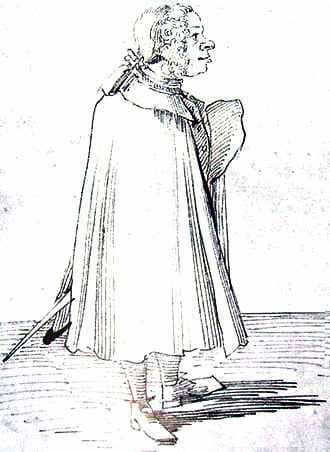
Giacinto Fontana, nicknamed “Farfallino”
Giacinto Fontana (1692–1739), nicknamed “Farfallino,” was primarily active in Rome between 1712 and 1736. Apparently, he specialized in singing soprano female roles, and was said to have had a high-pitched and small boyish voice. Rather feminine in appearance, he is known to have portrayed an occasional pregnant primadonna. It was his graceful stage appearance that probably earned him his nickname “Little Butterfly.” Graceful stage appearance aside, he seemed to have had a somewhat violent temper, as he almost fought a duel with another musician behind the scenes. “The music he sang does not suggest extraordinary technical abilities,” but he nevertheless created roles in operas by Bononcini, Scarlatti, Vivaldi, Vinci and the later works of Francesco Gasparini.
Mexican Independence Day 16 September: 10 Most Famous Mexican Composers

National Flag of Mexico
That particular incident started the Mexican War of Independence, which lasted until 1821. At that time, Spain withdrew and recognised Mexico as an independent country. Father Hidalgo is known as the Father of Mexican Independence, and every year on 16 September, the President of Mexico rings the 200-year-old bell and recites the “Grito de Dolores” speech. We thought it might be fun to celebrate Mexican Independence Day by featuring 10 of the most famous Mexican Composers.
Arturo Márquez
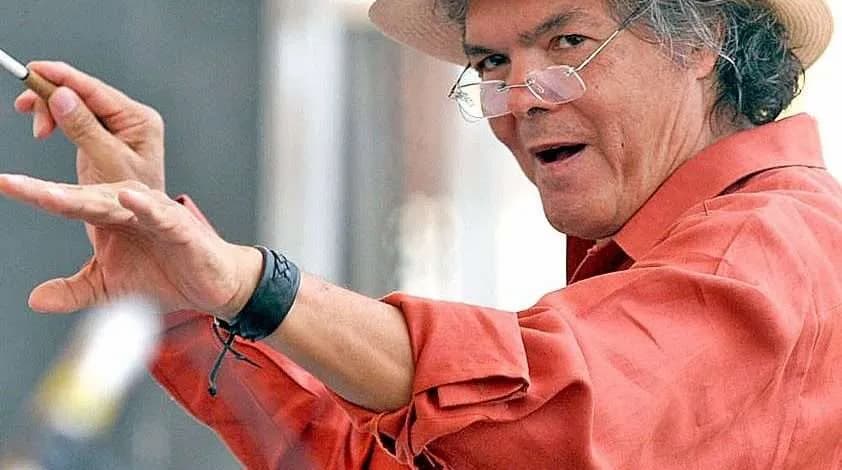
Arturo Márquez
Let’s get started with one of the most popular and most important Mexican composers of his generation, Arturo Márquez. Born in 1950 in the colonial town of Álamos deep in the Sonoran desert, Márquez has “always been enthralled by the music bubbling out of cafes and dance salons in Mexico.” Music had been in the ancestral DNA of his family, and he initially studied the violin and several other instruments as a teenager. Scholarships saw him further his education in Paris and at the California Institute of the Arts. Surprisingly, Márquez was virtually unknown outside his native Mexico until the early 1990s.
When Márquez was introduced to the world of Latin ballroom dancing, he responded with a series of pulsating “Danzones.” A fusion of dance music from Cuba and the Veracruz region of Mexico, Márquez quickly thrilled his audiences with its entrancing and seductive rhythms. His most famous Danzón No. 2 was commissioned by the National Autonomous University of Mexico, and because of its popularity, “it is often called the second national anthem of Mexico.” In fact, Márquez composed a series of “Danzones,” which are increasingly being used for ballet productions throughout the world. You can easily hear why Arturo Márquez is on my list of the 10 most famous Mexican composers.
Aniceto Ortega
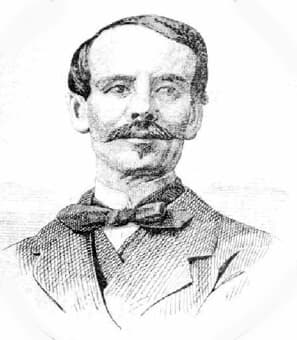
Aniceto Ortega
Let’s continue with a composer born shortly after Mexico achieved independence. Aniceto Ortega (1825-1875) was the youngest son of the prominent literary figure and statesman Francisco Ortega, who was active in the Mexican independence movement. He studied medicine and graduated in 1845. He had a distinguished career in medicine and was also a founding member of the Sociedad Filarmónica Mexicana.
Simultaneously, Ortega had a career as a musician. A scholar writes, “at the Gran Teatro Nacional on 1 October 1867, a military band and 20 pianists united in a grandiose performance of his march, the Zaragoza dedicated to the hero who defeated the French. Ortega composed a couple of other marches, but he is also known for his opera Guatimotzin, a setting dealing with the defence of Mexico by the last Aztec ruler Cuauhtémoc. Apparently, it was one of the earliest Mexican operas that used a native subject.
Felipe Villanueva
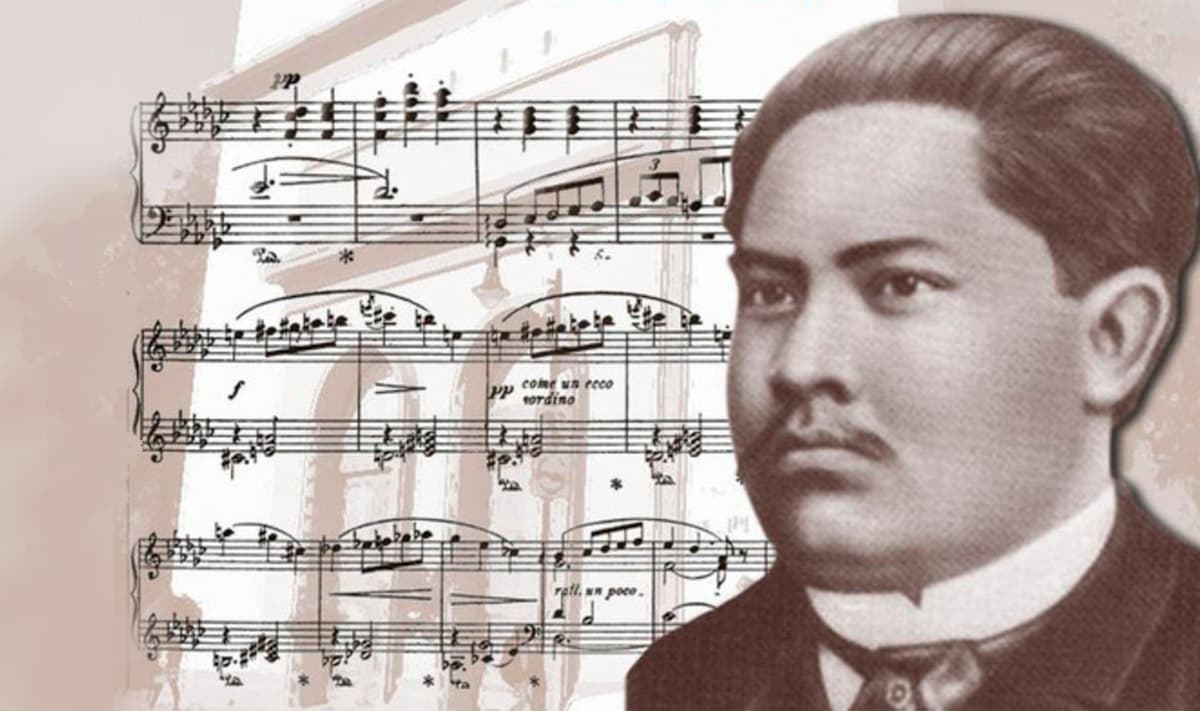
Felipe Villanueva
One of the best-known Mexican musicians, the violinist, virtuoso pianist, and pianist Felipe Villanueva (1862-1893), was the voice of Mexican musical romanticism. He was born during the historical period known as the “Porfiriato,” a period ruled by General Porfirio Diaz. He ruled the country with an iron fist continuously for almost 20 years, but the fraudulent 1910 election broke his grip, and Diaz was forced to resign and go into exile. His glowing legacy was a decade of regional civil war known as the Mexican Revolution.
Felipe Villanueva was a musical prodigy who composed a patriotic cantata for piano and four voices at the age of 10. He quickly followed up with a number of works for piano and he was accepted into the National Conservatory of Music at the age of 11. Only three years later we find him as a professional violinist performing with the orchestra of the Teatro Hidalgo. José Ramírez writes, “Villanueva developed his craft at a time when Italian music predominated in Mexico, coupled with reminiscences of the Viennese waltz introduced to the country in the time of Emperor Maximilian. Villanueva died at 31 and left countless works for piano and the comic opera Keofar.
Manuel Ponce

Manuel Ponce
The Mexican pianist and composer Manuel Ponce (1882-1948) was one of the leading Mexican musicians of his time. He was born into a musical family and continued his studies in Europe with Cesare Dall’Olio, Puccini’s teacher. Ponce also studied in Berlin for a short period of time before taking up piano teaching posts at home. He returned to Europe to study with Dukas until 1933 and founded several music magazines. Ponce worked closely with Segovia, and once he returned to Mexico, he became director of the National Conservatory and founded the chair of folklore at the National School of Music.
Ponce made significant contributions to the development of a Mexican national style, evolving away from Romanticism, “nationalism and the use of popular Mexican themes towards a more personal and contemporary style.” He is also credited with the revival of the guitar repertory and using the guitar as a concert instrument. But let’s not forget that he was an accomplished pianist who wrote many piano works that combine Lisztian virtuosity with popular Mexican tunes or phrases inspired by Mexican songs. Ponce is probably best known for his song Estrellita, but the catalogue of his works is vast and embraces a whole spectrum of musical genres and styles.
Silvestre Revueltas
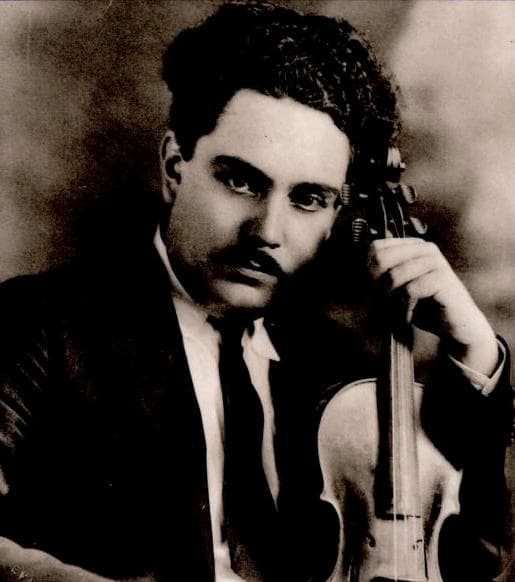
Silvestre Revueltas
Silvestre Revueltas (1899-1940), alongside Carlos Chávez, did much to promote contemporary Mexican music. He studied at the National Conservatory in Mexico City, St. Edward’s University in Austin, Texas, and the Chicago College of Music. Revueltas was an exceptional violinist, and he became assistant conductor of the National Symphony Orchestra of Mexico. Revueltas wrote a good deal of chamber music, including 4 String Quartets, orchestral and film music. He scored the 1939 film La noche de los mayas, which became one of his best-known compositions.
Arguably, Sensemayá is one of Revueltas’ most famous compositions. It is based on a poem by the Cuban poet Nicolás Guillén invoking a ritual Afro-Caribbean chant performed while killing a snake. We meet the leader of rituals known as “mayombero,” who offers the sacrifice of a snake to a god. Revueltas composed a couple of versions starting in 1937, and the music became ever more obsessive. “Finally, it reaches a massive climax by the entire orchestra in what sounds like a musical riot. The coda feels like the final dropping of a knife.”
Julián Carrillo
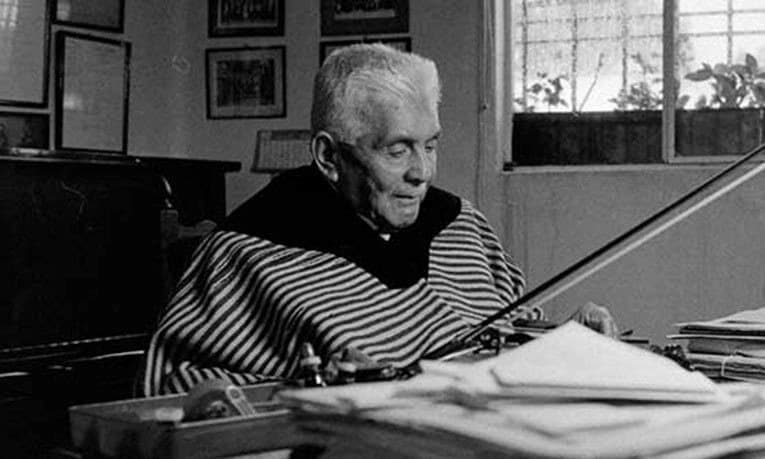
Julián Carrillo
Julián Carrillo (1875-1965) was born into an American family, and his great musical talents saw him study first at the National Conservatory of Mexico City and later at the conservatories of Ghent and Leipzig. Gerald R. Benjamin writes, “During these formative years, he shaped his critical philosophy of the practical application and examination of all theoretical precepts. The results were revolutionary and led him to a lifelong attempt at effecting greater accuracy among the discrepant postulates of physicists, mathematicians and music theorists, and at helping performers to apply, or at least understand them.”
That all sounds pretty complicated, but as I understand it, it applies to a theory of microtonal music created by Carrillo. Termed the “Thirteenth Sound,” Carrillo experimented with his violin and divided the twelve semitones of the tempered scale into multiple parts greater than the 12 classical tones. A biographer wrote, “Carrillo spent his life peering into an unsuspected microtonic world of sound. He has shattered and then remade our chromatic scale, and we might be tempted to call him the atom-splitter of music, except that the name gives no idea of the rich emotional world he has opened.” What is rather surprising is the fact that Carrillo came up with this system in 1895.
Ricardo Castro
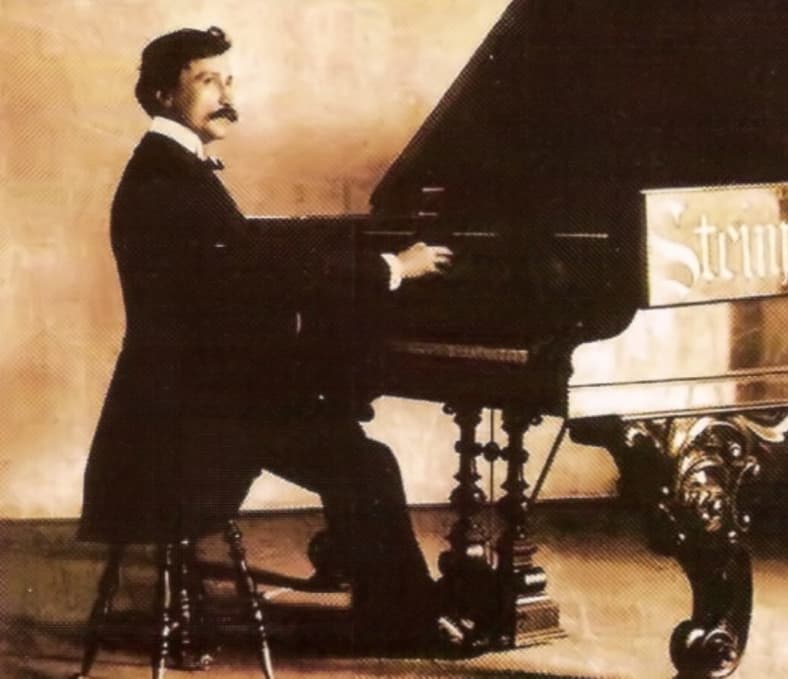
Ricardo Castro
Let’s take a break from microtonality and return to the time of Porfirio Diaz and the music of Ricardo Castro (1864-1907). A renowned concert pianist and composer, Castro is frequently considered Mexico’s last great romantic composer. Born in Naza, Durango State, his family moved to Mexico City, and the highly talented Ricardo enrolled in the conservatory. He studied composition with Melesio Morales and piano with Julio Ituarte, and by 1885, embarked on his first international tour that saw him perform in Philadelphia, Washington, and New York. He founded the “Sociedad Filarmónica Mexicana” and completed his opera Atzimba.
Castro furthered his studies with Eugen d’Albert and Teresa Carreño in Paris, and he visited the Bayreuth Festival. Once he returned to Mexico he was appointed music director of the National Conservatory of Music, reforming the curriculum and institute by implementing the latest teaching methods and musical styles. Castro crafted several symphonies, concertos, and countless pieces for piano in a pleasing and sophisticated Schumannesque style infused with Lisztian sparkle and virtuosity.
Gabriela Ortiz
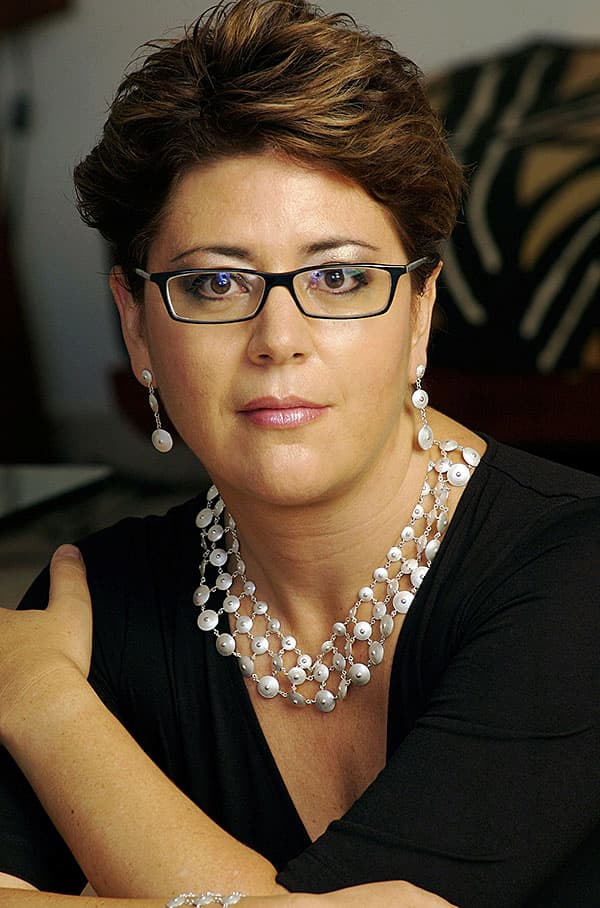
Gabriela Ortiz
Music by Mexican composers continues to flourish, and Gabriela Ortiz is one of the foremost composers in Mexico today. Critics describe her musical language as “achieving an extraordinary and expressive synthesis of tradition and the avant-garde; combining high art and folk and popular music in novel, frequently refined and always personal ways.” She grew up in Mexico City, and her parents were founding members of a renowned music ensemble dedicated to the performance of Latin American folk music. She started composition studies with several renowned Mexican composers and subsequently earned a doctorate in composition and electronic music from City University London.
Her music incorporates seemingly disparate musical worlds, “from traditional and popular idioms to avant-garde techniques and multimedia works.” As one critic wrote, “perhaps, the most salient characteristic of her oeuvre is an ingenious merging of distinct sonic worlds.” In addition, Ortiz allows herself the freedom to celebrate the Mexican folk heritage that played such an important role in her early life, and Atlas-Pumas, with its shifting melodies for violin and marimba, evoke a sonic walk through the streets of Guadalajara.
Candelario Huízar
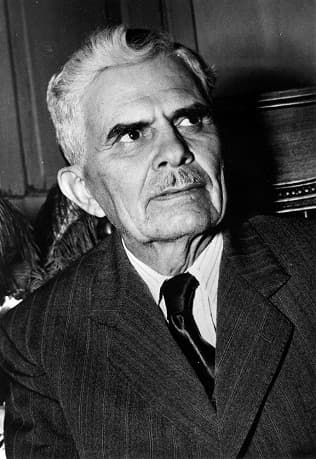
Candelario Huízar
After his death, Candelario Huízar (1883-1970) was remembered as a hero who rose from humble provincial origins to artistic pre-eminence. As Robert Stevenson writes, “he became a pillar of uncompromising Mexican nationalism in his later works.” Huízar came from a working-class family and was a goldsmith apprentice very early. He taught himself to play the guitar and joined the Jérez municipal band as a saxophonist in 1892. He played viola in a string quartet and was a horn player in the State Band in Zacatecas before entering the Conservatory as a composition student in 1918.
Huízar earned a meagre living in Mexico City when Carlos Chávez invited him in 1928 to join the Orquesta Sinfónica de México as a horn player and librarian. He composed four symphonies, leaving a fifth unfinished and a string quartet. However, he is best remembered for his tone poems. The première of Imágenes, a prizewinning four-movement impression of his hometown, was given in 1929, the fresh carnival piece Pueblerinas in 1931 and the bucolic symphonic poem Surco in 1935.
Carlos Chávez
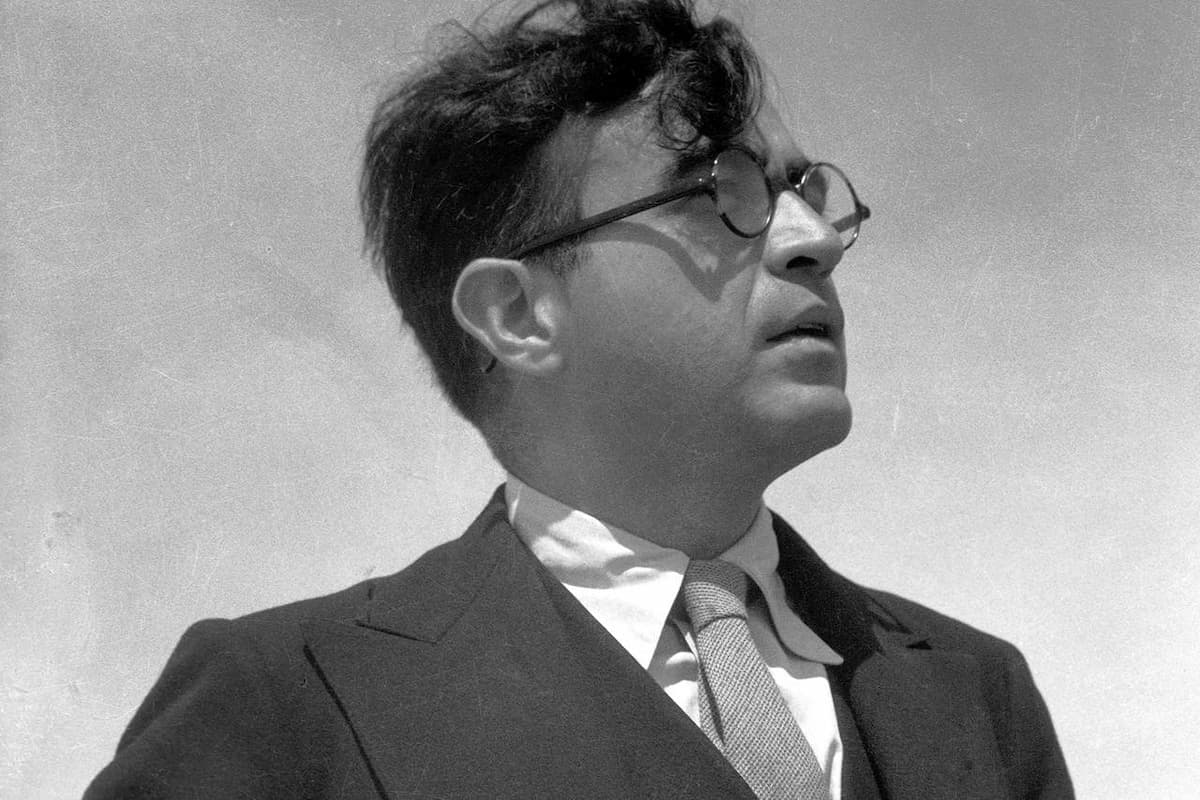
Carlos Chávez
Carlos Chávez (1899-1978) left an enduring legacy to the heritage of his native Mexico. He was born in Mexico City in 1899 and used much of his endless energy to further various aspects of composing, conducting, teaching, writing, and also as a government official. As an ethnomusicologist, he researched extensively the harmonies, rhythms, melodies, and instruments of the Indian cultures of Mexico. Chávez inherited Indian blood from his maternal grandfather, and he wrote, “The most important result was that it gave the young composers of Mexico a living comprehension of the musical tradition of their own country.”
Chávez composed six symphonies, and the second, or Sinfonia India, which uses native Yaqui percussion instruments, is probably the most popular. Composed in 1936, the work is scored for large orchestra and a hefty percussion section. The one-movement work is divided into sections by frequent changes in tempo, cross-rhythms, syncopation, and gorgeous instrumental colour, which contribute to a driving and primal energy. I trust you enjoyed this musical celebration in honour of Mexican Independence Day, and apologies if your favourite Mexican composer did not make my top 10.